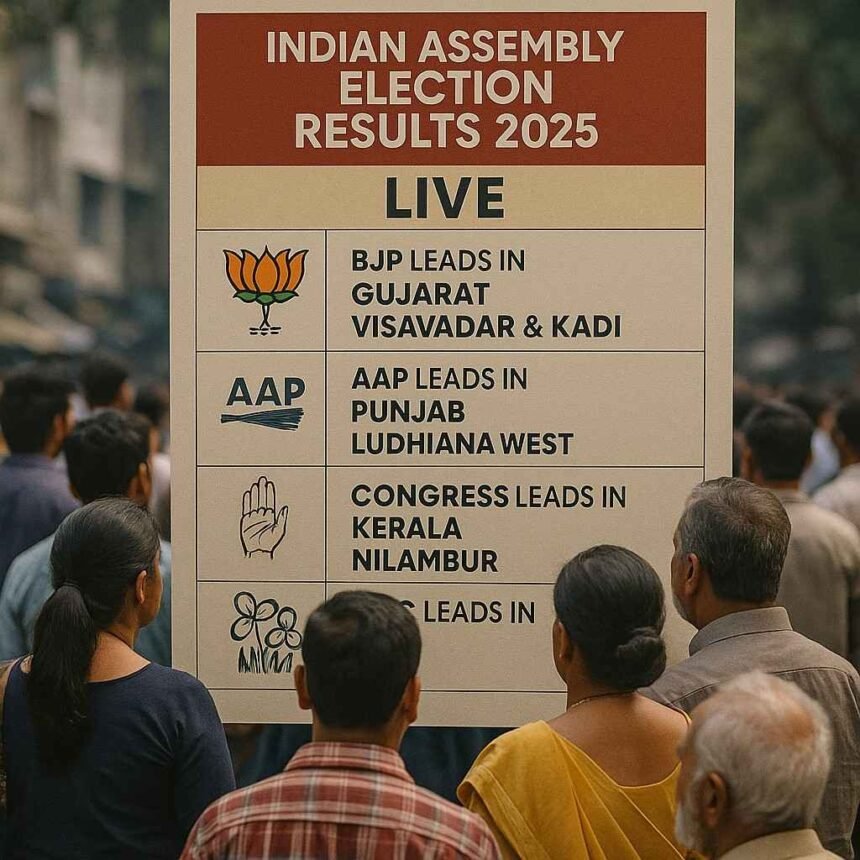The political heat across four crucial Indian states – Gujarat, Punjab, Kerala, and West Bengal – is at its peak today as the counting of votes for the Assembly Bypoll Results 2025 unfolds. These by-elections, covering five constituencies, are seen as a semi-final battle for the major players – BJP, Congress, AAP, and Trinamool Congress (TMC) – ahead of the assembly elections in 2026. The results are expected to set the political tone and momentum for the coming year’s high-stakes electoral contests.
In Gujarat, the Bharatiya Janata Party (BJP) has taken a lead in both Visavadar and Kadi assembly seats. This development is significant as Visavadar has been a seat where the BJP has struggled for the last 18 years. Breaking this losing streak here could give the party a psychological edge as it gears up for the 2026 state elections. According to the latest trends, BJP’s Kirit Patel is ahead in Visavadar while Rajendrabhai Chavda is comfortably leading in Kadi with a margin exceeding 13,000 votes. The state remains a saffron stronghold, and these leads only strengthen BJP’s political dominance in Gujarat.
Over in Punjab’s Ludhiana West, the Aam Aadmi Party (AAP) is making its presence felt strongly. AAP’s candidate, Sanjeev Arora, is leading with over 8,200 votes, keeping the ruling party ahead of its nearest rivals from the BJP and Congress. BJP’s Jiwan Gupta and Congress’s Bharat Bhushan Ashu are trailing behind. This lead, if it holds, will reinforce AAP’s confidence and standing in Punjab, especially as the party looks to consolidate its power in the state amidst internal challenges and opposition alliances.
Meanwhile, in Kerala’s Nilambur seat, the Congress-led United Democratic Front (UDF) is leading, with Aryadan Shoukath maintaining a margin of more than 6,000 votes. This seat falls under the Wayanad parliamentary constituency, a politically sensitive region, especially for the Congress, as it is closely associated with Priyanka Gandhi after Rahul Gandhi vacated the seat. Retaining Nilambur is vital for Congress to demonstrate its continued relevance in the state and to reassure its voter base ahead of the Lok Sabha elections in 2026.
In West Bengal’s Kaliganj constituency, the ruling Trinamool Congress (TMC) is comfortably leading with its candidate Alifa Ahamed securing a margin of over 14,000 votes against the BJP rival. The TMC’s stronghold in Bengal appears intact as Mamata Banerjee’s party continues to dominate despite the BJP’s aggressive campaigning in the region. The Kaliganj bypoll result is seen as a litmus test for TMC’s popularity before the 2026 assembly elections, and these results suggest that the party still enjoys widespread support in the state.
The voter turnout in these constituencies varied, reflecting regional political engagement. Kerala’s Nilambur reported the highest turnout at approximately 73.3%, signaling intense voter interest and active participation. West Bengal’s Kaliganj saw a 60.3% turnout, while Punjab’s Ludhiana West recorded a comparatively lower turnout of 51.3%. Gujarat’s turnout figures have not been fully reported, but polling was largely peaceful across both constituencies.
These bypolls carry more than just local significance; they are widely seen as indicators of public mood and political direction before the mega state elections due next year. For the BJP, retaining Gujarat and showing a strong performance is crucial to maintain its national narrative of development and governance. For AAP, maintaining its stronghold in Punjab is essential to justify its claim as a national alternative. Congress’s lead in Kerala is a much-needed morale booster for a party that has been struggling with internal challenges and declining electoral performances in several states. The TMC’s dominance in Kaliganj further cements its grip over West Bengal politics despite the BJP’s efforts to make inroads.
The final and official declaration of the results by the Election Commission is awaited, but the trends make it clear that regional factors, leadership influence, and local issues have played a decisive role in shaping voter preferences. These bypolls also reflect how national parties are tailoring their strategies for state-specific realities rather than relying solely on central narratives.
In conclusion, the 2025 Assembly Bypoll Results present a mixed but telling picture of India’s evolving political landscape. The BJP’s resurgence in Gujarat, AAP’s hold in Punjab, Congress’s stability in Kerala, and TMC’s dominance in Bengal underscore the regional complexities that will shape the 2026 electoral battles. As parties analyze these results, alliances may be reconsidered, campaign strategies refined, and leadership roles reassessed, making the road to the 2026 assembly elections even more intriguing.




